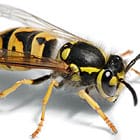They buzz. They are striped. They are very conspicuous. And they are one of the most aggressive pests. With a sweet tooth at one end and a painful sting at the other. It is of course the wasp.
And with Spring in the air and temperatures on the rise, we can expect to see and hear more of them. At the same time, other insect life begins to blossom, with bumble, honey and masonry bees more active. In the last month we started receiving calls to deal with wasps and if you’ve just been stung, then you may not necessarily wonder or care whether it was a bee or a wasp that dealt the painful blow!
Bees are hard-working insects, pollinating our plants and producing honey. They’re vital in giving us the delicious foods we eat as well as making sure we have beautiful flowers. They do a great deal for us, yet it’s true that many people can’t tell the difference between a honeybee, a bumblebee and a wasp
Wasps and bees are related, have a lot in common and people often mistake bees for wasps and vice versa. And then there are the things they don’t have in common. Honey bees have rounder, hairy bodies with black and brown and amber hoops and are not nearly as brightly coloured as their yellow and black cousin. Wasps are more aggressive and more likely to sting though that’s not to say that bees wont attack you if provoked.
So, what purpose do wasps serve? Well, in the early summer, they play an important role in the pollination of plants and flowers as they feed on the nectar. They also spend a lot of time hunting and catching small insects. The insect prey is chewed up and fed to the larvae in the nest. The larvae turn the exoskeleton of the dead insect into a sugary solution which is then fed back to the adult wasp, almost like a ‘red bull’ reward for all the hard work the wasps do.
In the early part of the season wasps are unlikely to attack and sting unless they feel threatened. They are on a mission to build the nest and feed the larvae inside. The end of the summer is a different story. All the larvae have changed into adult wasps – and consequently no more ‘red bull’. The wasps are no longer required to build the nest or feed larvae so now qualify for some well-deserved R and R. And that’s when the problems start.
Demob happy, wasps are more likely to be attracted to sugary food and drinks. And even more likely to attack and sting without being provoked. So, if you experience huge numbers of wasps in your house or garden there is likely to be a nest nearby.
To avoid a sting in the tail, give us a call today on freephone 0800 0283 703 or complete our on-line contact form.

